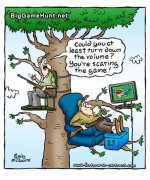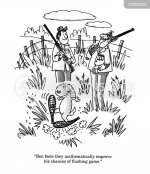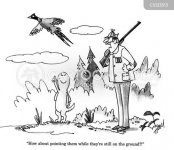Goosemaster
Well-known member
What is the strategy for getting close to pressured birds on public land?
100% agree Gimruis. I have walked wide and far to get to the "Other end" of cover to backtrack and come from another angle. I would add to think outside the box as well. A tiny rock pile, a patch of buckbrush or a fence line off the beaten path could prove worth some extra steps. I try not to let flushing birds speed me up. Some might push forward aggressively and then get frustrated at not ever getting close enough to the flushing birds. Meanwhile, they might pass right by birds holding tight that are shootable. Resist the temptation and slow down. I have literally seen grass moving as birds doubled back.If you are able to, approach the parcel/piece from the opposite direction as everyone else. Pressured birds are used to approaching danger from the same direction, over and over.
We had just a skiff of snow,and one cold day.I could not get within shotgun range but one time.Very spooky.I try to be as quiet as possible and push towards edges when hunting alone. If you have other people just set up blockers. The birds usually run quite a bit before flushing so someone will usually get a shot.
Otherwise wait for a good snow storm to hunt those birds.
My older lab always barks when she first leaves the car.Always has.Alsi barks when I get a bird, she loves hunting!!If you are able to, approach the parcel/piece from the opposite direction as everyone else. Pressured birds are used to approaching danger from the same direction, over and over.
I'll echo what has also already been stated. No noise whatsoever. Full stealth mode. When a rooster gets up, shoot it. If a hen flushes, don't be the moron who yells "hen!" and lets every bird in the countryside know you're there. The only noise you should be making is the blast of a shotgun.
I almost always hunt solo.Ive never need on an ass grabbing drive like these south Dakota guys.Good way to get your jimmy blown off!If you have a good dog trust the dog. Don't have the mindset of walking from point A to point B, if the dog catches a scent follow them no matter what even if it means walking places you've already been. Hunting solo is my favorite for this reason...I don't like hunting in groups where we try to keep the line and I have to pull my dog off a scent trail.
My strategy, or fortune, is having a stealthy dog.What is the strategy for getting close to pressured birds on public land?



ExactlyHave your cousin drop you off at the opposite side of the land that he is going to hunt.
Sitka is wanker.Old faded army gear.Hunt it the opposite way you think everyone else has been. Wear sitka camo
I'm not yelling hen,if u shoot a hen accidentally then it's Davy jones.I don't hunt in a Grab ass group playing padycaks like these guys in the mid west.I do enjoy talking to other guys.My strategy, or fortune, is having a stealthy dog.
I'm an outlier when it comes to not making extra noise, talking to the dog, etc. I figure they will hear us coming just by the noise we make the in cover. If they want to flush wild or want to run, I feel they are going to do that when they hear us walking.
I also record my hunts, so I am talking to the camera. In some cases, that might be a trade off, where even I might be a little more quiet if not for the camera. I guess I've just mellowed enough, and it is an acceptable trade-off, and more fun for me to be more relaxed about it. If I am hunting with others who have a different belief about talking, then I'll respect their wishes and reduce the volume and quantity of my talking, even if I don't have the same belief about the effect it has on the birds.
When I am hunting with others, if they are less experienced hunters, or the lighting conditions make it difficult to identify the birds, I'll help them by yelling hen or rooster. The more wind there is, the louder I'm yelling, because it can be darn hard to hear each other in 20+ mph wind sometimes. When I am by myself, I'll still sometimes say "hen", as reinforcement for the dog to let the bird go, and as an explanation to her of why I didn't shoot.The camera has a wide field of view, so birds get smaller really fast on the videos. By explaining that it was a hen, or what was going on with the bird, why I didn't shoot, etc., it helps my target audience. My target audience is future generations of hunters in my family, or younger hunters in general, if they get any value or fun out of watching the videos someday.
The reason why I say a stealthy dog is a benefit, is because they can cause some birds to hunker down instead of fleeing, if they aren't making a lot of noise when they get closer to the bird. In some situations, depending on the cover, my dog can be more catlike, and avoid making noise in the cover too. I feel that if a dog gets closer to a bird without the bird realizing the dog has located them, then when the bird does realize it, they might feel the dog is too close to try to make an escape and they might try to hunker down instead. This might happen more often with younger birds than the wise, older birds, by the very fact that the ones who hunker down are more likely to be taken out of the population faster.
If you have a dog that is stealthy when they get close to the bird, then it gives you extra time to get closer. Of course, that's up to the personality/instincts of the dog somewhat, and generally implies a pointer (more on this below). Getting them on a lot of birds when they are young can enforce more of that. If they have a teamwork mentality and it clicks that their job is to locate the birds and the hunter's job is to shoot the birds, so the dog can get the bird, that's ideal. More bird contacts helps with them figuring this out and helps with them knowing how stealthy they need to be when closing in on the birds, to keep the birds from fleeing.
I'll take this one step further. Not everyone has this ability, but if you have a dog that has a lot of drive and is a general purpose hunter/versatile breed, I feel that allowing them to hone their hunting skills on chipmunks, squirrels, moles, tweety birds, etc. when they are young and/or in the off season is a benefit. If you have a place to take them to where they can roam safely and be part of nature, great. If you have some land around your house, and you can let them roam safely, even better.
When I hunted flushers, I just had to watch closely and get to the dog quickly when they were getting birdy. Keeping them closer obviously helps. When the flushers weren't staying as close, bye bye birdy. It is definitely a different game with flushers, but I feel if you create a strong bond between the two of you, regardless of the dog's instincts and heritage, it is only going to help you when hunting.
As for strategy on how to work the field, I'll sometimes try to keep myself between the birds and heavier cover where they might be more likely to head towards. Or I'll keep a mental note of what direction earlier birds are flushing and try to use that to my advantage. The windier it is, if we are working cross wind, I'll follow the dog parallel, and a greater distance down-wind, so I have more time for a shot on a wild flush.
Working directly into the wind, when it is really windy, for walk up flushes, is always a bit iffy, because they can head downwind instantly. Not much to do there, except to be ready to pivot with each step taken. Some might approach them from the front of the dog. I don't do that, because the bird might be further than we think. Also, when windy, I would be giving the bird easy excuse to fly with the wind. By coming from the downwind side, at least I have a chance they will fly into he wind, even if just briefly.
My dog is very staunch when the bird is close. She is waiting for me to make a move. I'll sometimes try to get her to release with commands, but most of the time, I've found it works better to kick the cover before getting to where the bird is, in the hopes she'll break the point and pounce. That might not be the textbook way to do it, but it is what works best for me, rather than being right on top of the bird when it flushes, or having it flush behind me.
I try to find areas to hunt that other hunters might not be as likely to hunt. Maybe the way the roads are arranged, it is harder to get to that access. Or maybe there is a strip of cattails and/or water you have to walk through to get to higher ground on the other side that is surrounded by private land. Maybe it is just a matter of having to walk to a far, back corner (surrounded by private land), and others may not want to walk that far. In the winter, it might be a matter of snowed in/drifted roads that others won't drive on/walk on, that lead to the public land.
This may ruffle some feathers, but I think public land birds are *much* more challenging than private land birds. That doesn't mean I won't hunt private land birds, if given the opportunity, but I just view them completely differently. Similarly, when I get together, annually, with friends who come to town, who don't have the time or endurance for wild bird hunting, I view that completely differently. If I were to put them on a scale of challenge, it would be something like this:
(Game Farm/Preserve Birds)-----------(Private Land Birds)---------------------------------------------------------------------------(Public Land Birds)
If that didn't come out right due to viewing on a phone:
Level of challenge (on a scale of 1 to 10):
Game Farm/Preserver Birds - 1 to 2
Private Land Birds - 2 to 3
Public Land Birds - 9 to 10
Caveat: If the private land birds are hunted every day, then they are going to behave more like public land birds. I'm talking about private land birds that aren't hunted or are hunted occasionally or rarely.
I'll poke the bear even more. The percentage of public land birds who are 10s *might* be higher in Minnesota or Iowa (or other states) than South Dakota, if we include *all* public properties in the pheasant range, because there are fewer public acres and fewer birds, so they get pressured more.
When it comes to hunting these challenging birds on public land, I guess the biggest thing, for me, is to set my expectations appropriately. Some birds are going to flush wild, some birds will have already been pushed to private land or deeper into the cattails, and we are going to have to work harder and longer for the birds we do get. Perseverance and a positive attitude go a long way.
All the above is my personal opinion and experiences. Others may have different beliefs and experiences and I respect those.
View attachment 9225
View attachment 9226
View attachment 9227
CasperView attachment 9231
Out of curiosity, is there a designated line somewhere in Wyoming where the pattycake ends?
